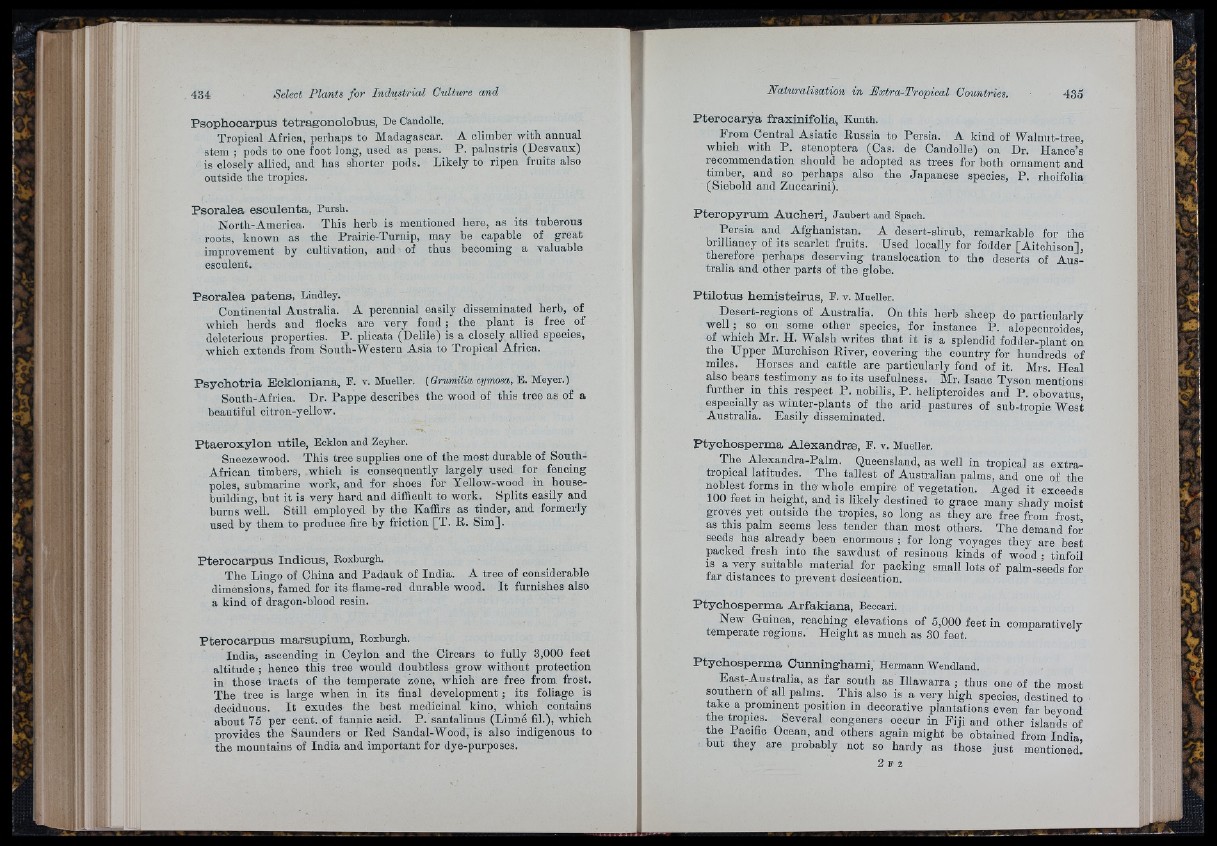
435
P s o p h o o a r p u s t e t r a g o n o lo b u s , De Candolle.
Tropical Africa, perhaps to Madagascar. A climber with annual
stem ; pods to one foot long, used as peas. P . palnstris (Desvaux)
is closely allied, and has shorter pods. Likely to ripen fruits also
outside the tropics.
P s o r a l e a e s o u l e n t a , Pursh.
North-America. This herb is mentioned here, as its tuberous
roots, known as the Prairie-Turnip, may he capable of great
improvement by cultivation, and of thus becoming a valuable
esculent.
P s o r a l e a p a t e n s , Lindley.
Continental Australia. A perennial easily disseminated herb, of
which herds and Hooks are very fond ; the plant is free ^ of
deleterious properties. P. plioata (Delile) is a closely allied species,
which extends from South-Western Asia to Tropical Africa.
P s y o h o t r i a B o k lo n ia n a , F. V. Mueller. (Orumilia cymosa, B. Meyer.)
South-Africa. Dr. Pappe describes the wood of this tree as of a
beautiful citron-yellow.
P t a e r o x y l o n u tile , Ecklon and Zeyher.
Sneezewood. This tree supplies one of the most durable of South-
African timbers, which is consequently largely used for fencing
poles, submarine work, aud for shoes for Yellow-wood in housebuilding,
but it is very hard and difficult to work. Splits easily and
burns well. Still employed by the Kaffirs as tinder, and formerly
used by them to produce fire by friction [T. R. Sim].
P t e r o c a r p u s I n d i c u s , Roxburgh.
The Lingo of China and Padauk of India. A tree of considerable
dimensions, famed for its flame-red durable wood. I t furnishes also
a kind of dragon-blood resin.
P t e r o c a r p u s m a r s u p iu m , Roxburgh.
India, ascending in Ceylon and the Circars to fully 3,000 feet
altitude ; hence this tree would doubtless grow without protection
in those tracts of the temperate zone, which are free from frost.
The tree is large when in its final development ; its foliage is
deciduous. I t exudes the best medicinal kino, which contains
about 75 per cent, of tannic acid. P . santalinus (Linné fil.), which
provides the Saunders or Red Sandal-Wood, is also indigenous to
the mountains of India and important for dye-purposes.
Pterocarya fraxinifolia, Kunth.
From Central Asiatic Russia to Persia. A kind of Walnut-tree,
which with P . stenoptera (Cas. de Candolle) on Dr. Hance’s
recommendation should be adopted as trees for both ornament and
timber, and so perhaps also the Japanese species, P. rhoifolia
(Siebold aud Zuccarini).
Pteropyrum Aucheri, Jaubert and Spach.
Persia and Afghanistan. A desert-shrub, remarkable for the
brilliancy of its scarlet fruits. Used locally for fodder [Aitchison],
therefore perhaps deserving translooation to the deserts of Aus!
tralia and other parts of the globe.
P tilotus hemisteirus, F. v. Mueller.
Desert-regions of Australia. On this herb sheep do particularly
well ; so on some other species, for instance P . alopecnroides,
of which Mr. H. Walsh writes th a t it is a splendid fodder-plant on
the Upper Murchison River, covering the country for huudreds of
miles. Horses and cattle are partioularly fond of it. Mrs. Heal
also bears testimony as to its usefulness. Mr. Isaac Tyson mentions
further in this respect P . nobilis, P. belipteroides and P. obovatus,
especially as winter-plauts of the arid pastures of sub-tropic West
Australia. Easily disseminated.
Ptychosperma Alexandrse, F. v. Mueller.
The Alexandra-Palm. Queensland, as well in tropical as extra-
tropical latitudes. The tallest of Australian palms, and one of the
noblest forms in th e whole empire of vegetation. Aged it exceeds
100 feet in height, and is likely destined to grace many shady moist
groves yet outside the tropics, so long as they are free from frost
as this palm seems less tender than most others. The demand for
seeds has already been enormous ; for long voyages they are best
packed fresh into the sawdust of resinous kinds of wood; tinfoil
is a very suitable material for packing small lots of palm-seeds for
far distances to prevent desiccation.
Ptychosperma Arfakiana, Beocari.
New Guinea, reaching elevations of 5,000 feet in comparatively
temperate regions. Height as much as 30 feet.
Ptychosperma Cunninghami, Hermann Wendland.
East-Australia, as far south as Illawarra ; thus one of the most
southern of all palms. This also is a very high species, destined to
take a prominent position in decorative plantations even far beyond
the tropics. Several congeners occur in F iji and other islands of
the Pacific Ocean, and others again might be obtained from India
but they are probably not so hardy as those ju s t mentioned.
2 F 2
:iP
' 1